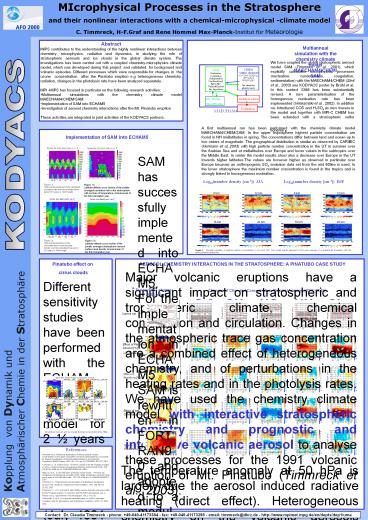Kein Folientitel - PowerPoint PPT Presentation
Title:
Kein Folientitel
Description:
MIcrophysical Processes in the Stratosphere and their nonlinear interactions with a chemical-microphysical -climate model C. Timmreck, H-F.Graf and Rene Hommel Max ... – PowerPoint PPT presentation
Number of Views:51
Avg rating:3.0/5.0
Title: Kein Folientitel
1
MIcrophysical Processes in the Stratosphere
and their nonlinear interactions with a
chemical-microphysical -climate model C.
Timmreck, H-F.Graf and Rene Hommel
Max-Planck-Institut für Meteorologie
- Abstract
- MIPS contributes to the understanding of the
highly nonlinear interactions between chemistry,
microphysics, radiation and dynamics, in studying
the role of stratospheric aerosols and ice
clouds in the global climate system. The
investigations has been carried out with a
coupled chemistry-microphysics climate model,
which was developed during this project and
validated for background and volcanic episodes.
Different processes which were responsible for
changes in the ozone concentration after the
Pinatubo eruption e.g heterogeneous chemistry,
radiation, changes in the photolysis rate have
been analyzed separately. - MPI -MIPS has focused in particular on the
following research activities - Multiannual simulations with the chemistry
climate model MAECHAM4/CHEM/SAM - Implementation of SAM into ECHAM5
- Investigation of aerosol chemistry interactions
after the Mt. Pinatubo eruption - These activities are integrated in joint
activities of the KODYACS partners.
Multiannual simulation with the chemistry climate
model MAECHAM4/CHEM/SAM
We have coupled the global stratospheric aerosol
model SAM (Timmreck et al., 2001), which
explicitly calculates microphysical processes
(nucleation, condensation, coagulation,
sedimentation) with the MAECHAM4/CHEM (Steil et
al., 2003) see KODYACS poster by Brühl et al. In
this context SAM has been substantially revised.
A new parameterisation of the homogenous
nucleation rate has been implemented (Vehkamäki
et al., 2002). In addition we introduced COS and
H2SO4 as new tracers in the model and together
with MPI-C CHEM has been extended with a
stratospheric sulfur scheme.
A first multiannual run has been performed with
the chemistry climate model MAECHAM4/CHEM/SAM. In
the upper troposphere highest particle
concentration are found in NH midlatitudes in
spring. The concentrations differ between land
and ocean up to two orders of magnitude. The
geographical distribution is similar as observed
by CARIBIC (Hermann et al.,2003) with high
particle number concentration in the UT in summer
over the Arabian Sea and at midlatitudes over
Europe and lower values in the subtropics over
the Middle East. In winter the model results show
also a decrease over Europe in the UT towards
higher latitudes.The values are however higher as
observed in particular over Europe because an
anthropogenic SO2 emission data set from the mid
80ties is used. In the lower stratosphere the
maximum number concentration is found in the
tropics and is strongly linked to homogeneous
nucleation.
Figure 3 Decadal logarithm of particle number
concentration in JJA and DJF. The model results
represent a five year average of a multiannual
simulation with the MAECHAM4/CHEM/SAM.
Pinatubo effect on cirrus clouds
Different sensitivity studies have been performed
with the ECHAM general circulation model for 2 ½
years after the Mt. Pinatubo eruption (July 1991
to December 1993) to study the possible potential
of volcanic emission to alter cirrus cloud
properties (Lohmann et al., 2003). Homogeneous
cirrus formation caused by sedimenting sulphate
particles produced in the eruption plume has been
compared with homogeneous cirrus formation in the
undisturbed atmosphere. The results turned out
to be very sensitive to the assumed size
distribution. While there is no trend on cloud
microphysical or optical properties in our second
scenario (trimodal size distribution), the first
scenario (monomodal size distribution) shows a
pronounced increase in ice water path and a
noticeable impact on cloud radiative forcing
Figure 4 Zonal Mean Aerosol and Ice Crystal
Number Concentrations for 1992.
Contact Dr. Claudia Timmreck - phone
49-040-41173384 - fax 49-040-41173298 - email
timmreck_at_dkrz.de - http//www.mpimet.mpg.de/en/dep
ts/dep1/uma































